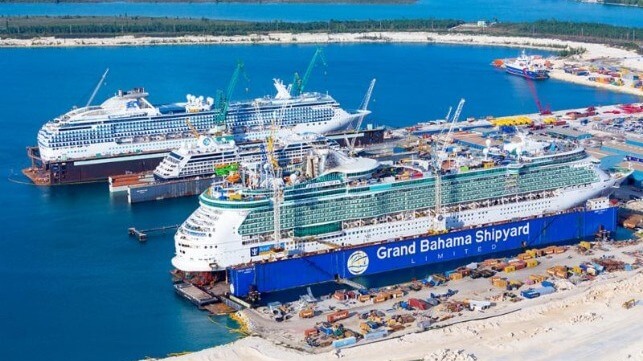Florida’s Okaloosa Country in the far western reaches of the state in the area known as the panhandle has signed a contingent contract to acquire and reef the famed ocean liner ss United States. The deal comes as the SS United States Conservancy which owns the vessel has struggled to find a new berth for the ship which is being evicted from its layup pier of nearly 30 years.
Responding to growing media reports, the Conservancy issued a statement late on Friday, August 30, confirming “we have entered into a contingent contract,” while warning that the proposal remains subject to “various contingencies.” The non-profit termed media coverage as “misleading stories,” saying the deal is not yet done and it would not comment until the country’s board has reviewed the proposal.
The Okaloosa Board of Country Commissioners is scheduled to meet on Tuesday, September 3, to review the proposal which local media reports said calls for a budget of up to $9 million for the project which would create the world’s largest artificial reef. The country is reportedly attracted to the deal as a means to spur tourism to the remote part of the state. Neighboring Escambia Country reefed USS Oriskany in 2006 and reports it attracts as many as 10,000 divers annually.
SS United States at 990 feet in length would be more than 100 feet long than Oriskany. Escambia was reported to be considering making a bid for ss United States as well but last week tabled the proposal. Among the concerns according to local media reports were the costs with the country commissioners seeking the support of the Tourist Development Department. The media coverage said they hoped to get $1 million from tourism and believed they had secured commitments for nearly $4 million of the estimated $8.6 million required for the project.
Okaloosa reportedly has agreed to pay $1 million to acquire ss United States and then would be responsible for towing the vessel to Florida’s Gulf Coast, additional remediation to meet environmental standards for reefing, and undertaking the reefing operation. The local news outlet Get the Coast reports the country believes it has $5 million in commitments toward the project. Raising the additional funding is one of the hurdles still to be overcome.
An environmental due diligence is underway with reports saying the initial results were favorable. The ship still has oil aboard as well as wiring and other contaminants. Other contingencies include securing an agreement from Penn Warehousing which owns the dock in Philadelphia and has been demanding the vessel depart so that the ship could stay past the court-ordered deadline for the removal of ss United States. The report says they anticipate closing on the acquisition of the liner by October 4.
Okaloosa is reported to have identified three possible locations for reefing the liner. It would be less than 25 miles from shore and the sites are said to offer depths and clearance, although speculation is that the liner’s icon funnels would be removed. Large parts of the interior would also have to be sealed because of the complex labyrinth of passageways which could trap even skilled divers.
“We understand that many of you are deeply concerned about the fate of the ss United States,” the Conservancy wrote to its supporters while saying, “Reefing is not the Conservancy’s preferred scenario.” They said they were aiming for a “more dignified outcome,” while admitting time is running out to meet the court mandate and thus far, no viable alternatives have emerged for an alternate berth.
“There are multiple discussions underway and many unresolved matters that make both the outcome and timing uncertain at this point,” the Conservancy said in its message on Friday. They said the group has been in discussions on a range of scenarios while saying reefing would be done in tandem with a land-based museum.
Okaloosa, which is also home to the Air Force Armament Museum, reportedly has committed $1 million to a museum. They would be responsible for acquiring and building or renovating a property to house the museum about what is called “America’s flagship.”
The Conservancy’s stated goal was repurposing the liner into a multi-use attraction. After acquiring the liner in 2011, they pursued many avenues including a proposal by Crystal Cruises to reactivate the ship. Referring to the lawsuit, the Conservancy wrote to supporters on Friday, “In the end, Penn Warehousing’s actions ended our ability to continue searching and advocating for a viable location for the project and we are unlikely to realize our shared dream.”
Conceived by one of America’s foremost naval architects, William Francis Gibbs, ss United States was built in the early 1950s as an Atlantic liner. On her maiden voyage in 1952, she shattered the Atlantic speed record and 72 years later remains the fastest passenger liner to have ever crossed the Atlantic. She operated for just 17 years before the end of U.S. government subsidies, a decision to fly U.S. military and government officials, and the growth of the commercial airlines ended the ship’s career. The U.S. Government ultimately took ownership and began seeking a buyer before selling the ship in 1980. Many plans were proposed, but none came to fruition.
Unless a last-minute “white knight” appears with a berth, the Conservancy is faced with completing the reefing deal or selling the liner for scrap. The court plans a follow-up to review progress on determining a plan for the vessel to be towed from her pier maintaining a September 12 deadline for the plan.












